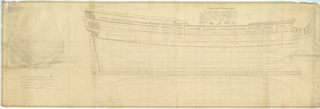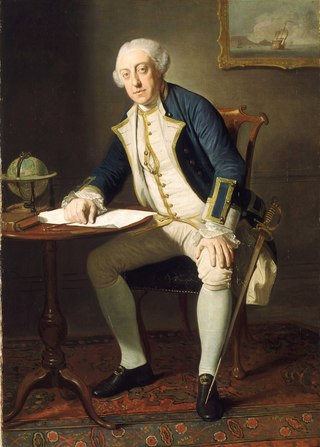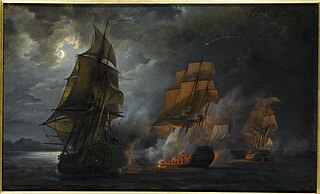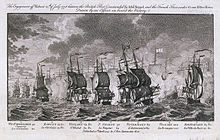
HMS Vanguard was a 70-gun third rate ship of the line of the Royal Navy, launched on 16 April 1748. She was built by Philemon Ewer at his East Cowes yard on the Isle of Wight to the draught specified by the 1745 Establishment, at a cost of £8,009. She was the fourth vessel of the Royal Navy to bear the name Vanguard.
HMS Antelope was a 50-gun fourth rate ship of the line of the Royal Navy, launched at Rotherhithe on 13 March 1703. She was rebuilt once during her career, and served in the Seven Years' War and the American Revolutionary War.

Admiral Philip Affleck was an admiral in the Royal Navy. He was the younger brother of Sir Edmund Affleck. Affleck held various commands throughout the latter half of the 18th Century, most notably as commander-in-chief of the Jamaica Station and as a Lord of the Board of Admiralty. Early in his career he fought at the Siege of Louisbourg where he was promoted commander after carrying out a successful cutting-out mission. He was promoted to post-captain a year later after impressing Admiral Edward Boscawen during the Battle of Lagos. Later in his career he joined Admiral Sir George Rodney in the West Indies and took part in the capture of Sint Eustatius. Between 1790 and 1792 he held the position of commander-in-chief of the Jamaica Station and between 1793 and 1796 he held his position as a Lord of the Board of Admiralty. Although his career was marked with long periods of inaction and unemployment Admiral Affleck was known as a good officer and was well respected by his peers.

HMS Ardent was a 64-gun third-rate ship of the line of the Royal Navy. She was built by contract at Blaydes Yard in Hull according to a design by Sir Thomas Slade, and launched on 13 August 1764 as the first ship of the Ardent-class. She had a somewhat turbulent career, being captured by the French in the action of 17 August 1779, and then re-captured by Britain in 1782.

HMS Raisonnable was a 64-gun third-rate ship of the line of the Royal Navy, named after the ship of the same name captured from the French in 1758. She was built at Chatham Dockyard, launched on 10 December 1768 and commissioned on 17 November 1770 under the command of Captain Maurice Suckling, Horatio Nelson's uncle. Raisonnable was built to the same lines as HMS Ardent, and was one of the seven ships forming the Ardent class of 1761. Raisonnable was the first ship in which Nelson served.

HMS Lichfield was a 50-gun fourth rate ship of the line of the Royal Navy, built at King's Yard in Harwich by John Barnard to the dimensions laid down in the 1741 proposals of the 1719 Establishment, and launched on 26 June 1746. She was wrecked on the Barbary Coast of North Africa on 28 November 1758.

HMS St Albans was a 64-gun third rate ship of the line of the Royal Navy, launched on 12 September 1764 by Perry, Wells & Green at their Blackwall Yard, London.

HMS Asia was a 74-gun third-rate ship of the line of the Royal Navy, launched on 2 December 1811 at Frindsbury.

The Foudroyant was an 80-gun ship of the line of the French Navy. She was later captured and served in the Royal Navy as the Third Rate HMS Foudroyant.

Belliqueux was a 64-gun ship of the line of the French Navy, launched in 1756.

Surveillante was an Iphigénie-class 32-gun frigate of the French Navy. She took part in the Naval operations in the American Revolutionary War, where she became famous for her battle with HMS Quebec; in 1783, she brought the news that the war was over to America. She later took part in the French Revolutionary Wars, and was eventually scuttled during the Expédition d'Irlande after sustaining severe damage in a storm. The wreck was found in 1979 and is now a memorial.

The siege of Louisbourg was a pivotal operation of the French and Indian War in 1758 that ended French colonial dominance in Atlantic Canada and led to the subsequent British campaign to capture Quebec in 1759 and the remainder of New France the following year.

HMS Stirling Castle was a 70-gun third rate ship of the line of the Royal Navy, built at Chatham Dockyard to the 1733 proposals of the 1719 Establishment, and launched on 24 April 1742.

HMS Defiance was a 58-gun fourth rate ship of the line of the Royal Navy, built to the dimensions laid out in the 1741 proposals of the 1719 Establishment at Deptford, and launched on 12 October 1744.
HMS Tilbury was a 58-gun fourth rate ship of the line of the Royal Navy, ordered from Portsmouth Dockyard on 17 December 1742 and built by Peirson Lock to the dimensions laid down in the 1741 proposals of the 1719 Establishment. She was launched on 20 July 1745.

HMS Dunkirk was a 60-gun fourth-rate ship of the line of the Royal Navy, built by Edward Allin at Woolwich Dockyard to the draught specified by the 1745 Establishment as amended in 1750, and launched on 22 July 1754.
HMS Burford was a 70-gun third rate ship of the line of the Royal Navy, built at Chatham Dockyard to the draught specified by the 1745 Establishment as amended in 1754, and launched in 1757.

Hector was a 74-gun ship of the line of the French Navy, lead ship of her class. Hector was launched in 1755 and fought in the American Revolutionary War during which she captured two ships of the British Royal Navy on 14 August 1778. In 1782, the ship was captured by the Royal Navy at the Battle of the Saintes in 1782. Taken into service by the Royal Navy, the vessel was renamed HMS Hector. On 5 September 1782. HMS Hector fought two French frigates. Severely damaged during the battle, and by a hurricane that followed later in September, Hector sank on 4 October 1782.

HMS Nymphe was a fifth-rate frigate of the British Royal Navy, formerly the French Nymphe, lead ship of her class. HMS Flora, under the command of Captain William Peere Williams, captured Nymphe off Ushant on 10 August 1780. Indiscriminately referred to as Nymph, Nymphe, La Nymph or La Nymphe in contemporary British sources, she served during the American, French Revolutionary and Napoleonic Wars. On 19 May 1793, while under the command of Captain Edward Pellew, she captured the frigate Cléopâtre, the first French warship captured in a single-ship action of the war. After a long period of service in which she took part in several notable actions and made many captures, Nymphe was wrecked off the coast of Scotland on 18 December 1810.

Triton was a 64-gun ship of the line of the French Navy designed by François Coulomb the Younger. She took part in the Seven Years' War and in the War of American Independence.



















